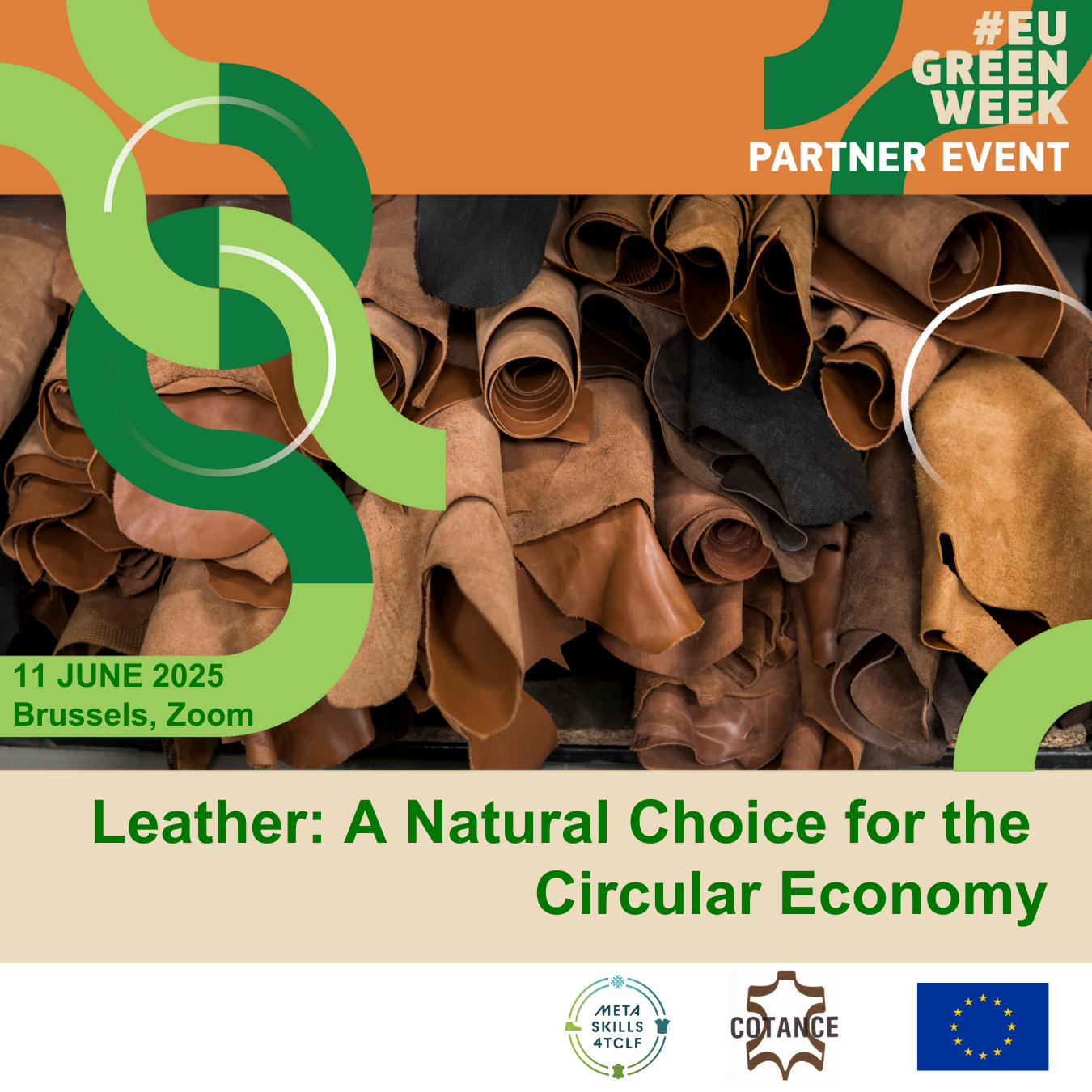Articles
29 August 2025
EU Green Week: Leather - A Natural Choice for the Circular Economy
Articles
29 August 2025
Sustainable competitiveness
Textile
Leather and fur
+2 more
Login / create an account to be able to react

The process of transforming raw hides into finished leather deserves to be studied at Harvard as a business case of circular innovation. By upcycling less than 1% of the animal’s economic value—skins and hides that would otherwise go to waste—tanners create a high-value, sustainable material that supports both economic and social progress. Leather is durable, repairable, and biodegradable, contributing directly to waste reduction and lower greenhouse gas emissions. The COTANCE webinar “Leather – A Natural Choice for the Circular Economy, held on June 11 during EU Green Week 2025 offered the latest insights and data that highlight leather’s unique circularity and environmental benefits.
COTANCE
COTANCE
Topics
Albania
Armenia
Austria
Belgium
Bosnia and Herzegovina
Bulgaria
Croatia
Cyprus
Czechia
Denmark
Estonia
EU-27
Finland
France
Georgia
Germany
Greece
Hungary
Iceland
Ireland
Italy
Kosovo
Latvia
Liechtenstein
Lithuania
Luxembourg
Malta
Moldova
Montenegro
Netherlands
North Macedonia
Norway
Poland
Portugal
Romania
Serbia
Slovakia
Slovenia
Spain
Sweden
Switzerland
Türkiye
Ukraine
Other
Academic / Research and VET Institutions
Business Support Organisation
Company with 250 or more employees
Consumer Organisations
Destination Management & Marketing Organisations
EU Institutions
Industry Associations and Chambers of Commerce
Media / Journalist Organisations
Networks and Federations / Confederations
SMEs (a company with less than 250 employees)
-
Transition Pathway's building blocks
-
-
Sustainable competitiveness
-
-
Industrial ecosystems
-
-
Textile
-
-
Textiles ecosystem areas
-
-
Leather and fur
-
Technology and Machinery
-
Business support and Communication
-
Share
The COTANCE webinar “Leather – A Natural Choice for the Circular Economy,” held on June 11 during EU Green Week 2025, highlighted new scientific findings that we are now sharing exclusively through the METASKILLS4TCLF project.
Scientific Insights from Gustavo Defeo, CEO of Ars Tinctoria CTC
Carbon-14 (C14) isotopic analysis demonstrated that leather—particularly vegetable-tanned leather—contains a bio-based content exceeding 95%, highlighting its predominantly natural origin. In contrast, many so-called “vegan” alternatives were shown to contain high proportions of petroleum-derived components, underscoring their synthetic composition and limited biodegradability.

Leather offers multiple end-of-life treatment scenarios, including:
- The transformation of leather waste into fertilizers and biostimulants, which can generate a net-positive carbon impact,
Energy recovery, which offers a carbon-balanced disposal method,
And the production of biochar, which enables carbon sequestration in soil systems—contributing to long-term climate change mitigation strategies.
Scientific Insights from Karl Flowers, Managing Director of Authenticae
Leather, composed predominantly of bio-based carbon (as confirmed by C14 analysis), demonstrates superior biodegradability compared to petroleum-based synthetic materials, which often release microplastics and show minimal degradation. Vegetable-tanned leather, particularly when finished with protein-based agents such as casein or collagen, can achieve disintegration rates exceeding 60–80% over 90 to 180 days under ISO-standardised conditions. In contrast, many so-called leather alternatives containing polymeric or wax-based coatings exhibited little to no meaningful biodegradation.
Practical Insights from Deborah Taylor, Managing Director of the Sustainable Leather Foundation
Transparency and traceability are essential for leather to function as a truly circular material, covering the full life cycle—from raw material sourcing to end-of-life.
She underscored the importance of supply chain collaboration—from farmers to brands—to reduce environmental impact. Case studies showed that leather production can significantly lower water, energy, and chemical use through continuous improvement.
The key takeaway: true material circularity requires durability, reparability, and safe biodegradation—all areas in which leather excels. When responsibly managed, leather exemplifies these qualities, contributing to a greener and more competitive economy.
Looking Ahead: Careers in the Leather Sector
Explore a career in the European tanning industry, where opportunities span across production, colour development, product design, research and innovation, quality control, customer service, environmental management, and corporate social responsibility.
Have questions? Feel free to contact COTANCE at cotance@euroleather.com
Manuel Rios, COTANCE President, Brussels, 11 June 2025
Comments (0)
See also
-
31
Welcome to the ‘Sustainable Business’ Community Workspace
- Categories
- Infrastructure Investments and funding R&I, techniques and technological solutions +19 more
-
17
Welcome to the 'Certification and Communication’ Community workspace
- Categories
- Infrastructure Investments and funding R&I, techniques and technological solutions +26 more
-
18
Welcome to the Digital Business Community Workspace!
- Categories
- Investments and funding R&I, techniques and technological solutions Skills +26 more




